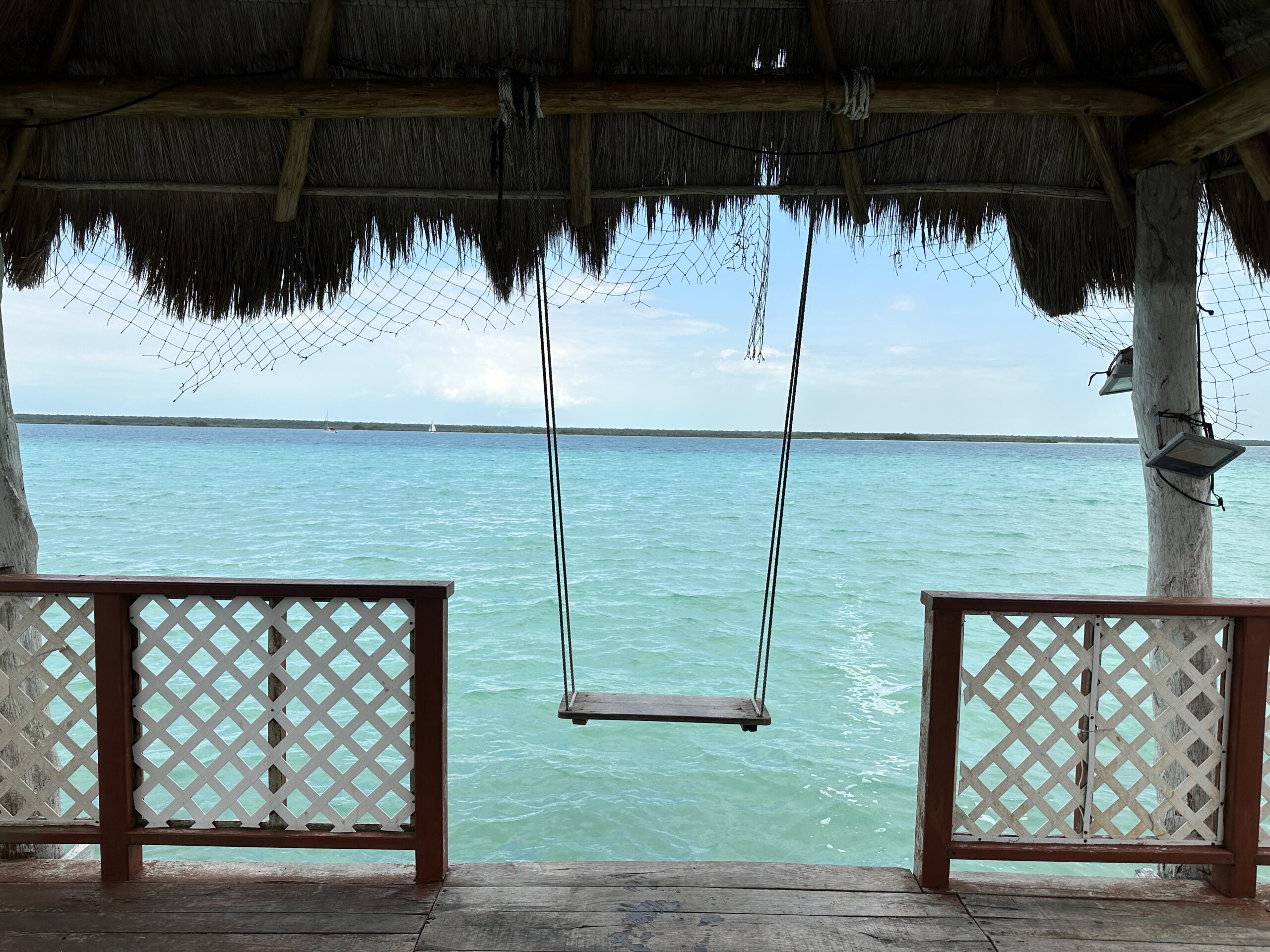Bacalar: La Laguna De Los Siete Colores

Laguna Bacalar is a crystal clear lagoon under 40 minutes by bus from Chetumal. It was created when a series of cenotes collapsed into one another, making the largest freshwater lake in Mexico. It’s long and narrow (26 miles long by only a mile and a quarter at its widest), and its seven colors come from the different depths of the collapsed cenotes, from just a few meters to over 100 meters deep. With the white limestone bottom, that creates different shades, from turquoise to deep blue, depending on the depth of the water.

Sadly, as beautiful as Bacalar is, it qualifies for our Pre-Apocalyptic Tour: places to see while they still exist (e.g. Cuba, Xochimilco, Florida…). [JK about Florida. Not that it won’t disappear soon, but we have no intention of visiting.] Because we can’t have nice things. While Bacalar is off the beaten path (over five hours from Cancun and almost three hours from Tulum), it still gets more tourists than it can sustain. They’ve made rules to protect the fragile ecosystem (no sunscreen, no boating on Wednesdays, etc), but they’re basically unenforceable. People who have known the lagoon for years say that it currently boasts far fewer of the seven colors than it once had.
While we can’t compare it to its more glorious past, its present seems pretty spectacular on its own. We were there for three days, and spent ridiculous amounts of time in the water. I don’t think I’ve ever been in a natural body of water that warm. Getting into the water, I had not even a hint of this-will-be-fine-in-a-minute.
The lagoon and setting are just so beautiful, bobbing in the warm water all day is more than enough “activity.” The water was so shallow at our hotel’s dock, we were able to walk out maybe 50 yards without getting above our necks. The only problem was the walking. The guides we read referred to the bottom of the lagoon as “soft white sand,” but that description, while technically accurate, fails to capture how creepy it felt. It was more like walking in pudding. Water shoes helped, but we picked up pool noodles, just so we could keep our feet out of the muck.
Los Rápidos de Bacalar
On our last day we went to Rápidos, the narrowest part of the lagoon. Laguna Bacalar is fed by an almost 300 mile long underground river that runs parallel to the coast, so there’s actually a current in the lake. In the wide parts you can’t really feel it, but it’s noticeable at the Rápidos. Despite its name, it’s not rapids at all, more like a natural lazy river.
There’s a little beach club there, a balneário, that’s set up a wooden deck running alongside. You can float downstream for about 5-10 minutes and then walk right back and repeat.

You can see in those pictures what looks like stone at the edge and the bottom, but it’s not stone. It’s actually living structures, stromatolites, the oldest life form on Earth. Laguna Bacalar is one of only about a dozen places on the planet where they still exist as anything but a fossil record.
The stromatolites are layers of sediment built up by bacteria that trap minerals and cement them into the rocklike structures. They’re kind of like coral, but it’s bacteria creating the physical structure, not polyps. Back in the day, they were responsible for pumping oxygen into the oceans, changing the Earth’s atmosphere in a way that made it possible for life as we know it to evolve. So, indirectly responsible for the platypus.
If that wasn’t enough Astounding Science, the stromatolite bed in Laguna Bacalar is over 6 miles long, which puts it in the running for the largest organism on Earth.
The stromatolites are, despite their backstory, actually quite fragile. Forgetting that they’re not stone and stepping on one is enough to wreak death and devastation. It’s amazing we’re permitted there at all.
It’s one thing to commune with nature. It’s another thing entirely to engage with geological time and the genesis of life on Earth. While floating down a lazy river with a pool noodle. No, it doesn’t get any better than this.
Xul-Ha
A couple of weeks after the visit described above, we returned to Laguna Bacalar. This time we visited the southern end of the lagoon, at Xul-Ha.
Xul-Ha is definitely sleepier than Bacalar, as well as being quite a bit closer to Chetumal. Bacalar is the touristy end of the spectrum (which still isn’t super touristy), whereas Xul-Ha is just a little village with access to water.
It’s so close to Chetumal, only a 25 minute cab ride from our apartment, you could go in the morning, swim all day, and come back same day. But we appreciate the comforts of showers and clean clothes, so we spent the night.

We stayed in a surprisingly modern hotel just a block from the lagoon.
The lagoon was so quiet compared to Bacalar, which was hardly a hub of activity. No boats, no tourists, just local families using the lagoon like their swimming pool.
We really enjoyed Mahahual and the snorkeling, but just bobbing in the lagoon all morning and again in the afternoon was its own form of joy. We now know to look for lakes, and not just oceans, as we travel.




























That’s incredible! What a delightful read. How many days did you spend? if you can’t use sunscreen do you just float around in giant hats and caftans?
We were there three days, two nights. Not enough, but we learned it’s close enough to day trip, so we can go whenever we like.
And yes, hats and swim shirts.
lol platypus
What kind of person finds the platypus amusing? Have you no compassion?